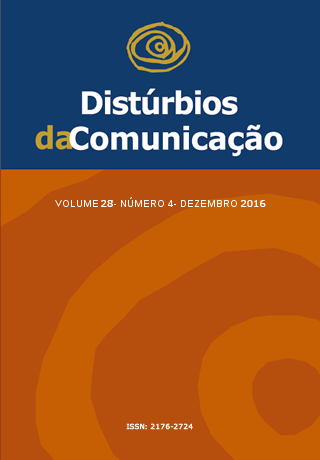Vocal habits of children from a Home of Social Care and Early Childhood Education
Keywords:
Child, Voice Quality, Habits, DysphoniaAbstract
Introduction: Institutional Environments favor vocal abuse in children. Studies indicate a relationship of vocal behavior in childhood to childhood dysphonia, considering them harmful to human interrelation and potential damage to the speaker self-image. The observation of parents and educators can contribute to the characterization of habits and children’s vocal behavior and studies aimed at the creation of programs to promote the vocal health of children. Objective: To identify the occurrence of inadequate vocal habits and possible signs associated in children aged five to nine years of a Home of Social Care and Early Childhood Education, as perceived by parents and educators. Methods: Two types of questionnaires containing questions about the vocal habits of children of this institution were analyzed, one directed to teachers and other to parents. Of the 67 questionnaires analyzed, 41 were answered by educators and 26 by a parent or caregiver. Data were analyzed using descriptive statistics (absolute and relative frequency). Results: According to opinion of the parents, it was found that inadequate vocal habit of higher occurrence was “speak louder than other children” with 57.7% of the sample, followed by “constantly screaming” and “making imitation of voices,” both in 46 2% of the sample. In questionnaires given to teachers, there is a higher occurrence of habit of “screaming constantly”, identified in 63.4% of children, followed by “talking too much” with 48.8%. Conclusion: Most of the children, in the opinion of parents and educators, had considered abusive habits and risk for dysphonia. Identifying these behaviors implies special attention in vocal care of these children, including guidance for parents and educators.Downloads
Metrics
Downloads
Published
Issue
Section
License
Copyright (c) 2017 Adriana de Oliveira Camargo-Gomes, Sandro Júnior Henrique Lima, Juliana Fernanda Dias da Silva, Jonia Alves Lucena

This work is licensed under a Creative Commons Attribution 4.0 International License.









